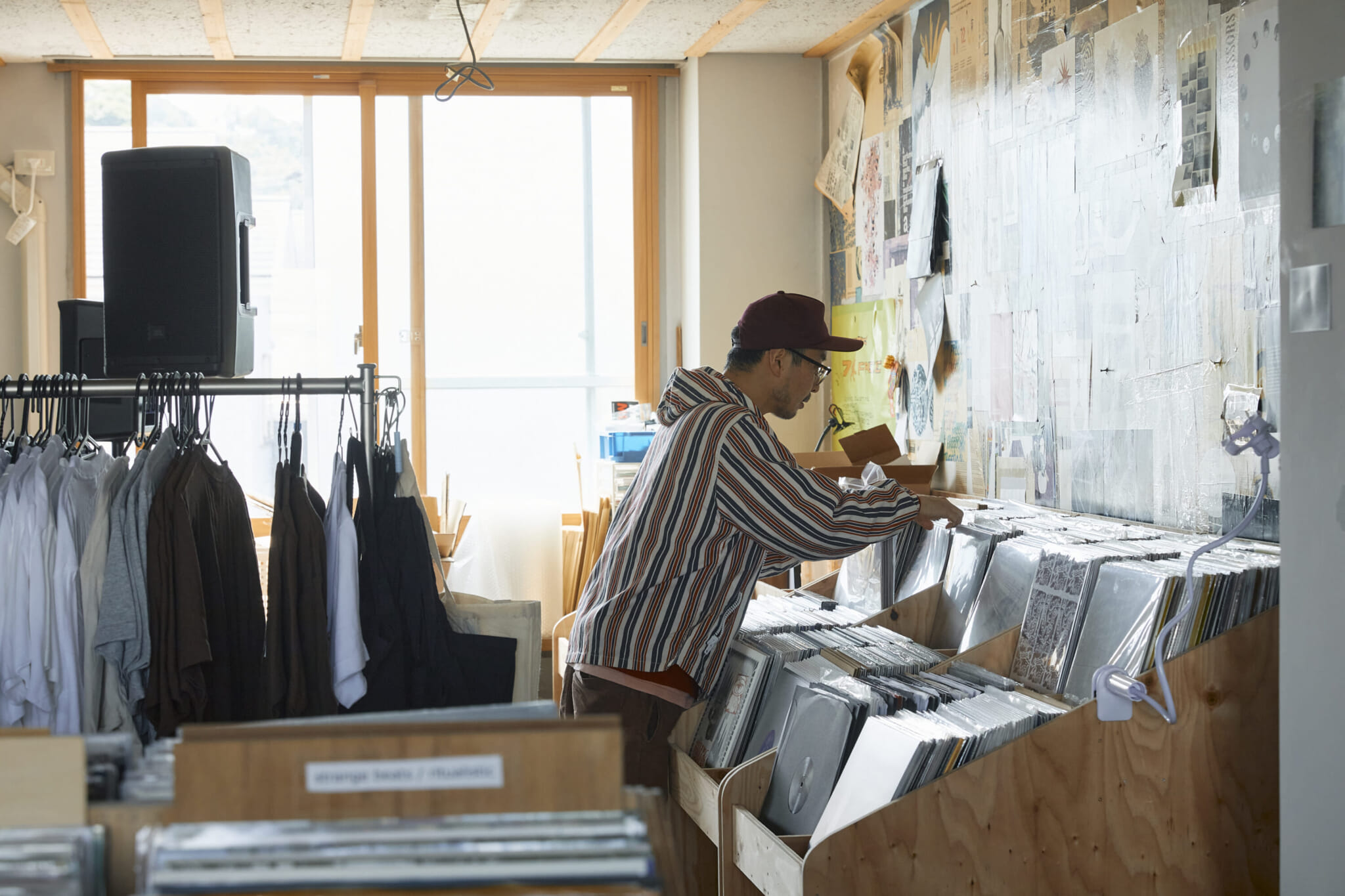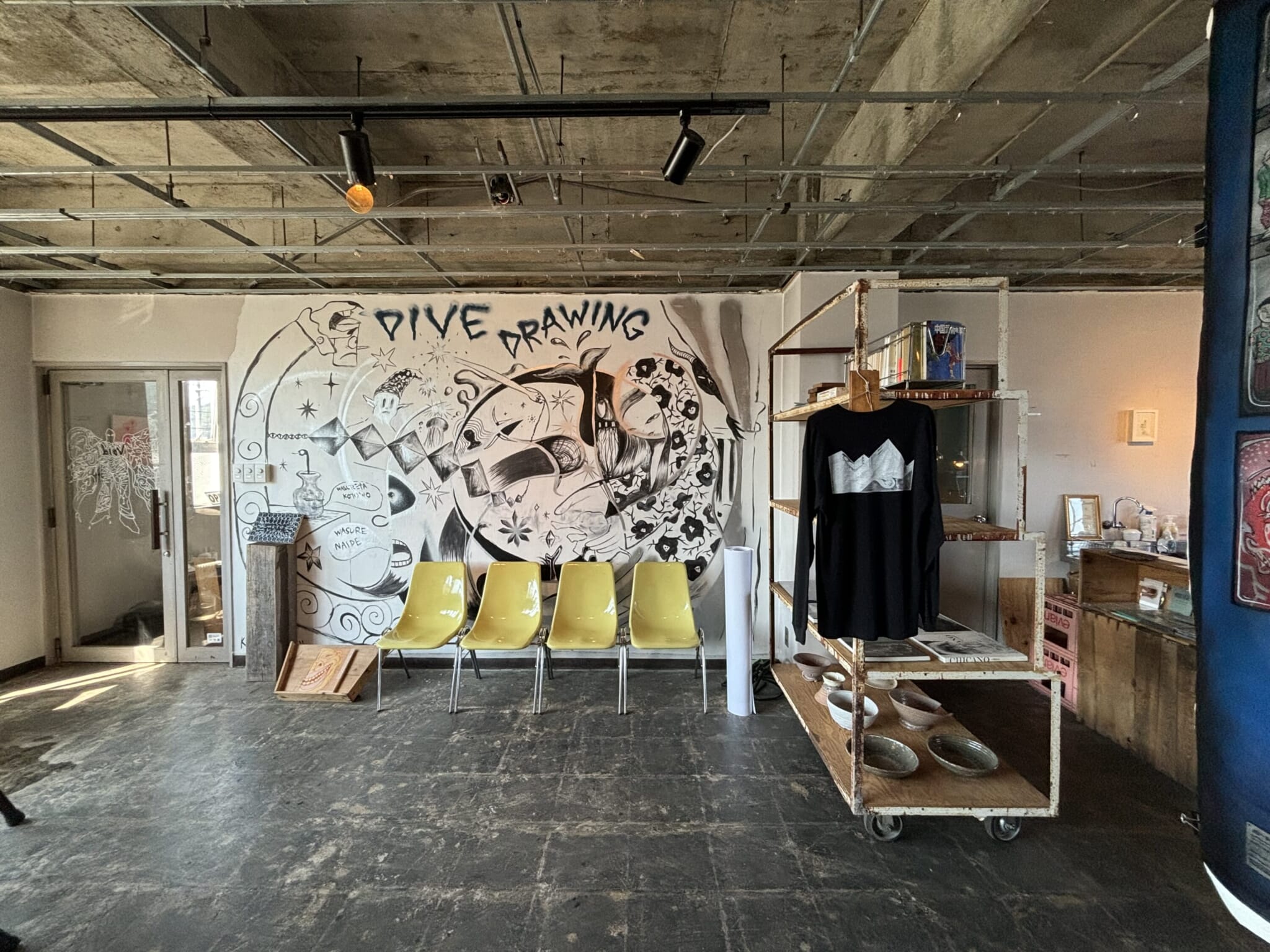Hop aboard a local train at Shin-Osaka Station and head northwest past forests, rice paddies and fields of corn. Journey through a lush, green landscape, watching as urban architecture gives way to rural
agriculture. After 90 minutes, you’ll find yourself at Hojomachi Station in Kasai, Hyogo Prefecture — the terminus of the single-track, one-car-train Hojo Line. From there, it’s a short walk to the Taisho Seimei Building, home of Tobira Records’ brick-and-mortar shop and Void Gallery, an unlikely cultural hub in a sleepy city in the countryside of Kansai.


Photo by Hiroshi Nakamura
Local Community and Global Culture
Since the two ventures opened in 2020, they have formed a creative community made up of a dedicated core of artists from Hyogo, the wider Kansai area and beyond. Enthusiasts travel across the prefecture to attend the building’s monthly events: music happenings courtesy of Tobira Records and artist exhibitions by Void Gallery.
Despite the relatively secluded location, artists from farther afield travel to Kasai, too. Welcoming guests from places like the UK, US and Spain’s Tenerife island, Tobira Records has become a regular stopping point for many visiting experimental and ambient musicians on tours of Japan. During these events, Void Gallery opens to serve drinks and show visitors around the space. The opposite is also true: Any exhibition opening by Void Gallery will likely see Tobira Records open its doors, welcoming customers to peruse the goods.
Gateway to Audio Exploration
Tobira Records is an online and physical record store run by ambient musician and ex-salaryman Takahiro Yorifuji (aka Hakobune) and Rosie Ball, an Australian illustrator. Four years ago, the pair left Tokyo and headed to Kasai, Yorifuji’s home city, to open a record shop specializing in vinyl, cassettes, CDs, apparel and other music-related paraphernalia.
The shop, whose name means “door” in Japanese, aims to be a doorway to new sonic experiences. Yorifuji’s decade of work as an ambient musician meant that they had a head start; connections made by the musician in both Kyoto and Tokyo allowed them to stock their shop with goods before they even had a physical store, with Yorifuji’s mother’s house acting as a storage place. A physical shop came care of Yorifuji’s childhood friend Daigo Ito, who, as luck would have it, had just opened up a space in Kasai: the Taisho Seimei Building.
The physical shop is a labor of love, as most of the business’s income comes from online sales to customers based in Japan and abroad. Open Friday to Monday from 7:30 a.m. to 12:30 p.m., any keen visitors have to be early to peek inside the welcoming space.
Inside, there is much to see; more than just a few rows of record boxes, the shop brims with items to admire, and touching is encouraged. A range of goods is on offer, as well as several musical instruments and samplers for customers to explore. You’ll also find a cassette wall and a big, comfy sofa. The space is light and airy, and purposefully so. “We hope that when customers come to our shop, they feel like they could spend ages just looking and discovering new things,” Yorifuji and Ball tell Tokyo Weekender.


Photo by Hiroshi Nakamura
Nurturing Artistic Expression
One floor above Tobira Records, Void Gallery, run by the aforementioned Daigo Ito and his wife, Naomi, is bringing art to Kasai. After graduating from art college, Ito tried the salaryman life, but like Yorifuji, he realized it wasn’t for him. He moved into architecture, heading back to his hometown of Kasai with Naomi to build his own place. Soon after, he found a 50-year-old building that he renovated and turned into Void. He hasn’t looked back.
The rarity of an urban-style space in the countryside isn’t lost on Ito, and that’s part of the reason why he was so keen to try running a gallery space in Kasai. A rural area, Kasai doesn’t even have a movie theater, and there are no other galleries nearby. “My desire to create something that did not exist was the starting point,” he says.
Void Gallery is a gray space of cool concrete and exposed piping, the sort of space you’d expect to find in Tokyo or another large city. It has wide windows that let the light in and provide views over the countryside at the back and the town’s only mall at the front. The gallery’s spacious and sleek interior is at odds with the rest of the town, which makes it seem like a hidden gem to those in the know.
Each month, the gallery hosts a new artist or event, featuring everything from ceramics and sculpture to drawing and photography. Previous guests have also been treated to pop-up shops, like one by bric-a-brac shop Meza, which came all the way from Ehime Prefecture.
